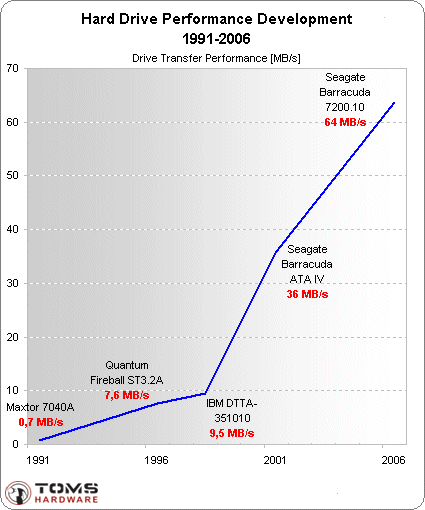15 Years Of Hard Drive History: Capacities Outran Performance
Performance Analysis
The huge increase in storage capacity makes even more obvious the fact that hard drive performance hasn't increased by nearly as much.
The actual performance increase between the 1991 Maxtor hard drive and the Barracuda 7200.10 750 GB is 0.7 MB/s to 64 MB/s, which represents a 91x increase. Comparing the 1991 drive to the 10,000 RPM WD Raptor's 85 MB/s, we get a 121x improvement.
While this already sounds disappointing, we should also take into account average file and program sizes. While an early Microsoft Word executable file did not occupy more than few megabytes on the hard drive and even less than that in main memory, today's application launch files can easily eat up several dozen megabytes, and they will even call in more code in the form of plugins and extensions. Adobe Photoshop CS2, for example, consumes over 60 MB of main memory, and most of it has to be pulled from the hard drive. Or think of opening a photo: years ago we were dealing with kilobyte-sized 640x480 JPEG files, while now we find that multi-megabyte images in resolutions like 3872x2592 are common.
Areal Density Vs. Performance
If you compare the areal density increase to the performance increase you will notice that there is a huge discrepancy: almost 6,000 times higher capacity versus not even a 100x increase in performance. In other words: capacity outran performance by 60 times! Is this something that our benchmark results will reflect?
Get Tom's Hardware's best news and in-depth reviews, straight to your inbox.
Current page: Performance Analysis
Prev Page Areal Density Analysis Next Page Time Required To Write A Full Platter
Patrick Schmid was the editor-in-chief for Tom's Hardware from 2005 to 2006. He wrote numerous articles on a wide range of hardware topics, including storage, CPUs, and system builds.
-
There is a typo in the article:Reply
Quantum's Fireball was available about five years after the 40 GB Maxtor drive discussed above,
It should be 40MB, obviously -
badcat "And Samsung, finally, may have a decent advantage in the future with a possible hybrid hard drive; it is the only firm in this quartet that manufactures both magnetic and Flash storage." WRONG! This technology existed in enterprise level hard disks for some time now.Reply
